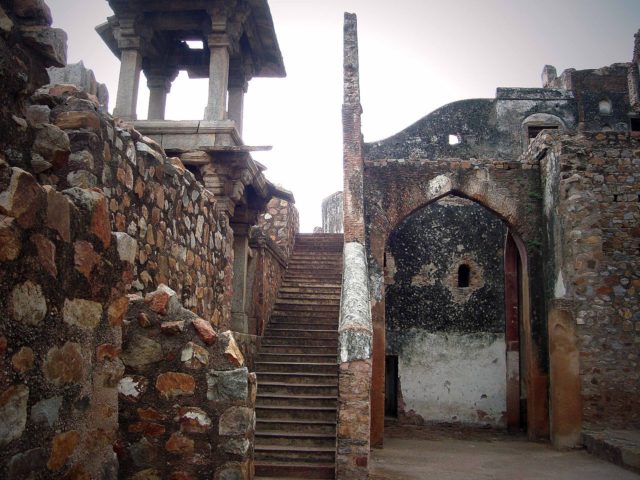afar Mahal is the last monumental structure built by the Mughals during the final years of their empire. It served as a summer palace and was named after the last ruler of the dynasty, Bahadur Shah Zafar II.
It has two components: the main structure built in the 18th century by Emperor Akbar Shah II and the main entrance gate, known as Hathi Gate, which was reconstructed by Zafar in the 19th century. Located in a village in South Delhi, the palace is quite removed from the local community, but it can easily be approached from the Darga of Qutbuddin Bakhtiar Kaki, one of the most famous landmarks in the village of Mehrauli.
There are graves in the village in a separate marble enclosure made by Jahandar Shah for his father Badahur Shah I. Several Shahs are buried there, notably the second shah, Shah Alam II, who is known for having been blinded by Ghulam Qadir.
He was a Rohilla leader and the first puppet ruler under the Marathas and later the British. His son Akbar Shah II was also buried in the palace, as was the son of the last emperor Bahadur Shah Zafar, Mirza Fakruddin. Zafar’s greatest wish was to be buried among his ancestors, but he was deported to Rangoon by the British in 1857 after the First War of Indian Independence and died there without any commemoration.

The emperor died in 1862 and was hastily buried at night in the presence of a few family members and under the supervision of a British officer. Until the 20th century, the grave was unmarked, but today there is a tablet in his name erected at the location. Zafar’s grave became a shrine both for locals and those across India and Pakistan who venerate him as a Pir (saint) and come to pay respects.

The palace was a three-storey structure built in red sandstone decorated with marble. The grand gate opening is called Hathi Gate which was shaped to allow decorated elephants to pass through. The structure has a beautifully furnished balcony from where the Royals could oversee events and processions.

The upper balcony is divided into marble decorated chambers, and the arches are prime examples of Rajasthani architecture. On the central arch, there is an inscription that credits the building of the gate. There are also two ornate medallions on both sides of the arch in the form of giant lotuses. The chambers were made in typical Indian style, but the external decorations from the 19th century have integrated several European styles.

One of these European additions is a fireplace which can be seen on an inside wall. Near the palace is the Moti Masjid which has two exits: one to the south and the other to the north. Bahadur Shah built the mosque as a private place for the royal family. It is a unique structure made of white marble.

Except for the gate, the entire palace is abandoned and ruined. The roof has collapsed almost entirely, and only a small part has been restored and is supported with wooden planks. Until today, only sketches have been made about the reconstruction of the dilapidated building, but nothing has been seriously undertaken.

In 1920, it was declared a protected monument under the Ancient Monuments Preservation Act and listed as a conservation area for the Indian National Trust for Art and Cultural Heritage. There are plans to transform parts of the building into the Mughal Museum which will attract visitors. The museum is considered a tribute to Emperor Zafar who was known more for his poetic skills than his administrative achievements.
